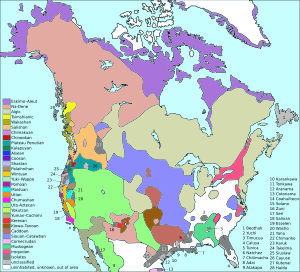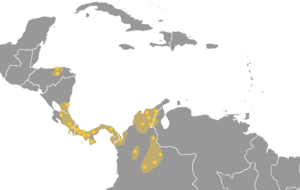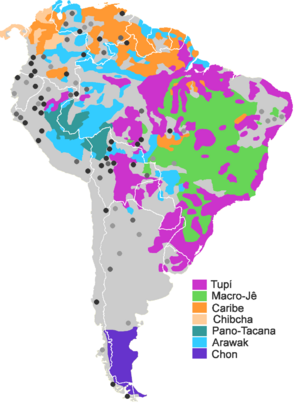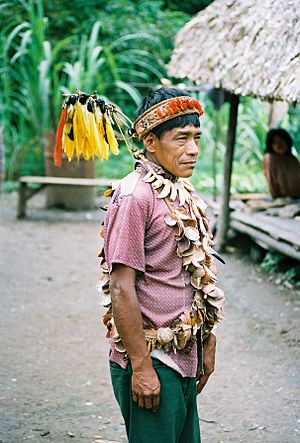Indigenous languages of the Americas facts for kids
The Indigenous languages of the Americas are the languages spoken by the native peoples of the Americas before people from other continents arrived. More than a thousand of these languages are still used today. Sadly, many others have completely disappeared. These languages don't all come from the same origin; instead, they belong to about a hundred different language families. Some are even "language isolates," meaning they aren't related to any other known language.
Many ideas have been suggested about how these languages might be connected. One famous idea was the "Amerind hypothesis," but most experts don't agree with it because it had some problems.
According to UNESCO, most Indigenous languages in the Americas are in danger of disappearing. Many are "dormant," meaning they don't have native speakers anymore, but some people are trying to learn them as a heritage language. The most widely spoken Indigenous languages are Southern Quechua (in Peru and Bolivia) and Guarani (in Paraguay), each with about six or seven million speakers. Guarani is even an official language in Paraguay, alongside Spanish!
Only a few other languages have more than a million speakers. These include Aymara and Nahuatl (almost two million each), and the Mayan languages like Kekchi, Quiché, and Yucatec (about one million each). In the United States, about 372,000 people spoke an Indigenous language at home in 2010. In Canada, this number was 133,000 in 2011. In Greenland, about 90% of people speak Greenlandic, which is the most common Eskaleut language.
Contents
A Look at the Past
Before Europeans arrived, over a thousand different languages were spoken by various groups across North and South America. The first Europeans came around the 11th century (with the Norse in Greenland) and later in the late 15th century (with Christopher Columbus). Some Indigenous cultures, like the Maya, even had their own writing systems, such as the famous Maya script.
The number of speakers for these languages varied a lot. Some, like Quechua, Aymara, Guarani, and Nahuatl, had millions of speakers. Others had only a few hundred. After Europeans arrived, some new "creole languages" developed. These were mixtures of European, Indigenous, and African languages.
European countries and the new nations they formed had different ideas about Indigenous languages. For example, in Brazil, some religious leaders learned and promoted the Tupi language. In many Spanish colonies, missionaries learned local languages to share their religious messages. In the British colonies, John Eliot translated the Bible into the Massachusett language, publishing the first Bible printed in North America.
However, Europeans also tried to stop Indigenous languages from being used. They made their own languages official, destroyed texts in other languages, and insisted that Indigenous children learn European languages in schools. This led to many Indigenous languages losing speakers and facing cultural suppression. By the 18th and 19th centuries, European languages like Spanish, English, and Portuguese became the main languages of the new countries in the Americas.
Today, many Indigenous languages are in danger, but others are still strong and used daily by millions. Some Indigenous languages have even become official languages, like Guaraní in Paraguay. In other places, official status is limited to certain regions where the languages are most spoken. For example, in Greenland, Kalaallisut became the only official language in 2009. In the United States, Navajo is the most spoken Native American language, with over 200,000 speakers. During World War II, Navajo men were even recruited as code talkers because their language was so unique.
How Languages Started
Scientists have different ideas about where Indigenous languages in the Americas came from. One main idea is that people arrived in the Americas in a few different groups, and each group spoke a different language. Another idea suggests that people came in many different waves, each speaking a unique language. Some even think that languages arrived already diversified from the "Old World" (Europe, Asia, Africa).
One theory by Roger Blench (2008) suggests that different groups of people from northeastern Asia traveled along the Pacific coast. These groups already spoke various languages, which then spread and developed in the Americas.
How Many People Speak Them
Many countries in the Americas, like Mexico, Bolivia, Venezuela, Guatemala, and Guyana, officially recognize most of their native Indigenous languages. Bolivia and Venezuela have even made all Indigenous languages official in their constitutions. Other countries, like Canada and the United States, let their provinces or states decide their own language policies.
Here is a list of some widely spoken and officially recognized Indigenous languages:
| Language | Number of speakers | Official Recognition | Area(s) Language is spoken | Source |
|---|---|---|---|---|
| Guaraní | 6,500,000 | Paraguay (Official Language)
Bolivia Corrientes, Argentina Tacuru, Mato Grosso do Sul, Brazil |
Paraguay, Bolivia, Argentina, Brazil | |
| Southern Quechua | 5,000,000 (outdated figure) | Bolivia (Official Language)
Peru (Official Language) Jujuy, Argentina
|
Bolivia, Peru, Argentina, Chile | |
| Nahuatl | 1,700,000 | Mexico | Mexico | |
| Aymara | 1,700,000 | Bolivia (Official Language)
Peru (Official Language)
|
Bolivia, Peru, Chile | |
| Qʼeqchiʼ | 1,100,000 | Guatemala
Belize Mexico |
Guatemala, Belize, Mexico | |
| Kʼicheʼ | 1,100,000 | Guatemala
Mexico |
Guatemala & Mexico | |
| Yucatec Maya | 890,000 | Mexico
Belize |
Mexico & Belize | |
| Ancash Quechua | 700,000 (outdated figure) | Peru | ||
| Mam | 600,000 | Guatemala
Mexico Zapatista Autonomous Municipalities (De facto), Mexico |
Guatemala & Mexico | |
| Tzeltal | 560,000 | Mexico
Zapatista Autonomous Municipalities (De facto), Mexico |
Mexico | |
| Mixtec | 520,000 | Mexico | Mexico | |
| Tzotzil | 490,000 | Mexico
Zapatista Autonomous Municipalities (De facto), Mexico |
Mexico | |
| Zapotec | 480,000 | Mexico | Mexico | |
| Kichwa | 450,000 | Ecuador | Ecuador & Colombia (Cauca, Nariño, Putumayo) | |
| Wayuu (Guajiro) | 420,000 | Venezuela
La Guajira, Colombia |
Venezuela & Colombia | |
| Kaqchikel | 410,000 | Guatemala
Mexico |
Guatemala & Mexico | |
| Otomi | 310,000 | Mexico | Mexico | |
| Totonac | 270,000 | Mexico | Mexico | |
| Mapuche | 260,000 | Cautín Province, La Araucanía, Chile (Galvarino, Padre Las Casas) | Cautín Province, La Araucanía, Chile (Galvarino, Padre Las Casas) | |
| Ch'ol | 250,000 | Mexico
Zapatista Autonomous Municipalities (De facto), Mexico |
Mexico | |
| Mazateco | 240,000 | Mexico | Mexico | |
| Qʼanjobʼal | 170,000 | Guatemala
Mexico |
Guatemala & Mexico | |
| Huasteco | 170,000 | Mexico | Mexico | |
| Navajo | 170,000 | Navajo Nation, United States | Southwestern United States | |
| Mazahua | 150,000 | Mexico | Mexico | |
| Miskito | 140,000 (outdated figure) | North Caribbean Coast Autonomous Region, Nicaragua
Honduras (Gracias a Dios) |
Nicaragua, Honduras | |
| Chinanteco | 140,000 | Mexico | Mexico | |
| Mixe | 130,000 | Mexico | Mexico | |
| Tlapaneco | 130,000 | Mexico | Mexico | |
| Poqomchiʼ | 130,000 | Guatemala | Guatemala | |
| Purepecha/Tarasco | 120,000 | Mexico | Mexico | |
| Achí | 120,000 | Guatemala | Guatemala | |
| Ixil | 120,000 | Guatemala
Mexico |
Guatemala & Mexico | |
| Yaru Quechua | 100,000 (circa; outdated figure) | Peru | ||
| Cree | 96,000 [incl. Naskapi, Montagnais] | Northwest Territories, Canada | Canada | |
| Tarahumara | 74,000 | Mexico | Mexico | |
| Tz’utujil | 72,000 | Guatemala | Guatemala | |
| Kuna | 61,000 | Colombia (Chocó & Antioquia) | Colombia (Chocó & Antioquia) | |
| Paez | 60,000 | Colombia (Cauca, Huila, Valle del Cauca) | Colombia (Cauca, Huila, Valle del Cauca) | |
| Chuj | 59,000 | Guatemala
Mexico |
Guatemala & Mexico | |
| Kalaallisut (Greenlandic) | 57,000 | Greenland | Greenland | |
| Amuzgo | 55,588 | Mexico | Mexico | |
| Tojolabʼal | 51,733 | Mexico
Zapatista Autonomous Municipalities (De facto), Mexico |
Mexico | |
| Garífuna | 50,000 (circa; outdated figure) | Guatemala
Belize North Caribbean Coast Autonomous Region, Nicaragua Honduras (Atlántida, Colón, Gracias a Dios) |
Guatemala, Belize, Nicaragua, Honduras | |
| Ojibwe | 48,000 | Canada
United States |
Canada & United States | |
| Tikuna | 47,000 | Colombia (Leticia, Puerto Nariño, Amazonas) | Amazonas regions of Brazil and Colombia | |
| Chatino | 45,000 | Mexico | Mexico | |
| Huichol | 44,800 | Mexico | Mexico | |
| Mayo | 39,600 | Mexico | Mexico | |
| Inuktitut | 39,475 | Nunavut, Canada
Northwest Territories, Canada |
Nunavut, Northwest Territories, Quebec and Labrador, Canada | |
| Chontal Maya | 37,072 | Mexico | Mexico | |
| Wichi | 36,135 | Chaco, Argentina | Chaco, Argentina | |
| Tepehuán | 36,000 | Mexico | Mexico | |
| Soteapanec | 35,050 | Mexico | Mexico | |
| Shuar | 35,000 | Ecuador | Ecuador | |
| Blackfoot | 34,394 | Alberta, Canada & Montana, United States | ||
| Sikuani | 34,000 | Colombia (Meta, Vichada, Arauca, Guainía, Guaviare) | Colombia (Meta, Vichada, Arauca, Guainía, Guaviare) | |
| Jakaltek | 33,000 | Guatemala
Mexico |
Guatemala & Mexico | |
| Kom | 31,580 | Chaco, Argentina | Chaco, Argentina | |
| Poqomam | 30,000 | Guatemala | Guatemala | |
| Ch'orti' | 30,000 | Guatemala | Guatemala | |
| Kaiwá | 26,500 | Mato Grosso do Sul, Brazil | ||
| Sioux | 25,000 | South Dakota, United States | US | |
| Oʼodham | 23,313 | Tohono Oʼodham Nation, United States
Salt River Pima–Maricopa Indian Community, United States Mexico |
Arizona, United States | |
| Kaigang | 22,000 | Brazil | ||
| Guambiano | 21,000 | Cauca Department, Colombia | Cauca Department, Colombia | |
| Cora | 20,100 | Mexico | Mexico | |
| Yanomamö | 20,000 | Venezuela | Brazil & Venezuela | |
| Nheengatu | 19,000 | São Gabriel da Cachoeira, Amazonas, Brazil | Brazil, Colombia, Venezuela | |
| Yup'ik (Central Alaskan) & (Siberian) | 18,626 | Alaska, United States | Alaska, United States | |
| Huave | 17,900 | Mexico | Mexico | |
| Yaqui | 17,546 | Mexico | Mexico | |
| Piaroa | 17,000 | Vichada, Colombia | Vichada, Colombia | |
| Sakapultek | 15,000 | Guatemala | Guatemala | |
| Western Apache | 14,012 | San Carlos Apache Nation, United States
Fort Apache Indian Reservation, United States |
Arizona, United States | |
| Xavante | 13,300 | Mato Grosso, Brazil | ||
| Keresan | 13,073 | New Mexico, United States | ||
| Cuicatec | 13,000 | Mexico | Mexico | |
| Awa Pit | 13,000 | Nariño Department, Colombia | Nariño, Colombia | |
| Cherokee | 2,320 | Eastern Band of Cherokee Indians, North Carolina, United States
Cherokee Nation of Oklahoma, United States |
US (Oklahoma & North Carolina) | |
| Karu | 12,000 | Venezuela
Guaviare Department, Colombia São Gabriel da Cachoeira, Amazonas, Brazil, (Baníwa language) |
Guaviare, Colombia & Amazonas, Brazil, (Baníwa language) | |
| Awakatek | 11,607 | Guatemala
Mexico |
Guatemala
Mexico |
|
| Chipewyan | 11,325 | Northwest Territories, Canada | Northwest Territories, Canada | |
| Pame | 11,000 | Mexico | Mexico | |
| Wounaan | 10,800 | Colombia (Chocó, Cauca, Valle del Cauca) | Colombia (Chocó, Cauca, Valle del Cauca) | |
| Choctaw | 9,600 | Choctaw Nation of Oklahoma, United States | Oklahoma & Mississippi, United States | |
| Moxo | 10,000 | Bolivia | Bolivia | |
| Kogi | 9,900 | Magdalena, Colombia | Magdalena, Colombia | |
| Zuni | 9,620 | New Mexico, United States | ||
| Guajajara | 9,500 | Maranhão, Brazil | ||
| Sumo | 9,000 | North Caribbean Coast Autonomous Region, Nicaragua | North Caribbean Coast Autonomous Region, Nicaragua | |
| Mopán | 9,000–12,000 | Guatemala
Belize |
Guatemala & Belize | |
| Tepehua | 8,900 | Mexico | Mexico | |
| Mawé | 8,900 | Brazil (Para & Amazonas) | ||
| Terêna | 8,200 | Mato Grosso do Sul, Brazil | ||
| Sipakapense | 8,000 | Guatemala | Guatemala | |
| Ika | 8,000 | Colombia (Cesar & Magdalena) | Colombia (Cesar & Magdalena) | |
| Mi'kmaq | 7,140 | Canada and United States | ||
| Tukano | 7,100 | São Gabriel da Cachoeira, Amazonas, Brazil Mitú, Vaupés, Colombia |
Amazonas, Brazil & Vaupés, Colombia | |
| Minica Huitoto | 6,800 | Amazonas, Colombia | Amazonas, Colombia | |
| Hopi | 6,780 | Arizona, United States | ||
| Piapoco | 6,400 | Colombia (Guainía, Vichada, Meta) | Colombia (Guainía, Vichada, Meta) | |
| Cubeo | 6,300 | Vaupés, Colombia | Vaupés, Colombia | |
| Kayapo | 6,200 | Brazil (Pará & Mato Grosso) | ||
| Yukpa | 6,000 | Venezuela
Cesar, Colombia |
Venezuela, Colombia | |
| Chiquitano | 5,900 | Bolivia | Brazil & Bolivia | |
| Guarayu | 5,900 | Bolivia | Bolivia | |
| Macushi | 5,800 | Venezuela | Brazil, Venezuela, Guyana | |
| Chimané | 5,300 | Bolivia | Bolivia | |
| Tewa | 5,123 | New Mexico, United States | ||
| Timbira | 5,100 | Brazil (Maranhão, Tocantins, Pará) | ||
| Sanumá | 5,100 | Venezuela | Brazil & Venezuela | |
| Muscogee | 5,072 | Muscogee (Creek) Nation, OK, United States | United States (Oklahoma, Alabama, Florida) | |
| Chontal of Oaxaca | 5,039 | Mexico | Mexico | |
| Tektitek | 5,000 | Guatemala | Guatemala | |
| Barí | 5,000 | Colombia (Cesar & Norte de Santander) | Colombia (Cesar & Norte de Santander) | |
| Camsá | 4,000 | Putumayo, Colombia | Putumayo, Colombia | |
| Kulina | 3,900 | Brazil (Amazonas) & Peru | ||
| Crow | 3,862 | Montana, United States | ||
| Mohawk | 3,875 | Mohawk Nation of Akwesasne, Canada | Canada (Ontario & Quebec) and United States (New York) | |
| Kashinawa | 3,588 | Brazil & Peru | ||
| Munduruku | 3,563 | Pará & Amazonas, Brazil | ||
| Tunebo/Uwa | 3,550 | Boyacá, Colombia | Boyacá, Colombia | |
| Ayoreo | 3,160 | Bolivia | Bolivia | |
| Desano | 3,160 | Bolivia | Bolivia | |
| Wapishana | 3,154 | Bonfim, Roraima, Brazil
Guyana |
Bonfim, Roraima, Brazil
Guyana |
|
| Yaminawa | 3,129 | Bolivia | Bolivia | |
| Mocoví | 3,000 | Chaco, Argentina | Chaco, Argentina | |
| Iñupiaq | 3,000 | Alaska, United States
Northwest Territories, Canada |
Alaska, United States & Northwest Territories, Canada | |
| Puinave | 3,000 | Guainía, Colombia
Venezuela |
Guainía, Colombia & Venezuela | |
| Cuiba | 2,900 | Colombia (Casanare, Vichada, Arauca) | Colombia (Casanare, Vichada, Arauca) | |
| Tupi-Mondé | 2,886 | Rondônia, Brazil | ||
| Yuracaré | 2,700 | Bolivia | Bolivia | |
| Wanano | 2,600 | Vaupés, Colombia | Vaupés, Colombia | |
| Shoshoni | 2,512 | US | ||
| Bora | 2,400 | Amazonas, Colombia | Amazonas, Colombia | |
| Cofán | 2,400 | Colombia (Nariño, Putumayo) | Colombia (Nariño, Putumayo) | |
| Kanamari | 2,298 | Amazonas, Brazil | ||
| Fox (Mesquakie-Sauk-Kickapoo) | 2,288 | Sac and Fox Nation, United States
Mexico |
US & Mexico | |
| Waiwai | 2,217 | Guyana | Brazil, Guyana | |
| Karajá | 2,137 | Brazil | ||
| Huarijio | 2,136 | Mexico | Mexico | |
| Slavey | 2,120 | Northwest Territories, Canada | Northwest Territories, Canada | |
| Chichimeca | 2,100 | Mexico | Mexico | |
| Koreguaje | 2,100 | Caquetá, Colombia | Caquetá, Colombia | |
| Tiriyó | 2,100 | Brazil, Suriname | ||
| Xerente | 2,051 | Tocantins, Brazil | ||
| Uspanteko | 2,000 | Guatemala | Guatemala | |
| Fulniô | 1,871 | Pernambuco, Brazil | ||
| Pakaásnovos (wari) | 1,854 | Rondônia, Brazil | ||
| Wiwa | 1,850 | Cesar, Colombia | Cesar, Colombia | |
| Weenhayek | 1,810 | Bolivia | Bolivia | |
| Matlatzinca | 1,800 | Mexico | Mexico | |
| Tacana | 1,800 | Bolivia | Bolivia | |
| Tłı̨chǫ Yatıì | 1,735 | Northwest Territories, Canada | Northwest Territories, Canada | |
| Cavineña | 1,700 | Bolivia | Bolivia | |
| Jupda | 1,700 | Amazonas, Colombia | Amazonas, Colombia | |
| Zacatepec Mixtec | 1,500 | Mexico | Mexico | |
| Seneca | 1,453 | Six Nations of the Grand River First Nation, Ontario, Canada | Ontario, Canada | |
| Movima | 1,400 | Bolivia | Bolivia | |
| Tlingit | 1,360 | Alaska, United States | Alaska, United States | |
| Inuinnaqtun | 1,310 | Nunavut, Canada
Northwest Territories, Canada |
Alaska, United States & Northwest Territories& Nunavut, Canada | |
| Kiowa | 1,274 | Oklahoma, United States | ||
| Ka'apor | 1,241 | Maranhão, Brazil | ||
| Aleut | 1,236 | Alaska, United States | Alaska, United States | |
| Gwichʼin | 1,217 | Alaska, United States
Northwest Territories, Canada |
Alaska, United States & Northwest Territories, Canada | |
| Inuvialuktun | 1,150 | Nunavut, Canada
Northwest Territories, Canada |
Nunavut, Canada & Northwest Territories, Canada | |
| Arapaho | 1,087 | US | ||
| Macuna | 1,032 | Vaupés, Colombia | Vaupés, Colombia | |
| Guayabero | 1,000 | Colombia (Meta, Guaviare) | Colombia (Meta, Guaviare) | |
| Comanche | 963 | US | ||
| Chocho | 810 | Mexico | Mexico | |
| Maricopa/Piipaash | 800 | Salt River Pima–Maricopa Indian Community, AZ, United States | Arizona, United States | |
| Rama | 740 | North Caribbean Coast Autonomous Region, Nicaragua | North Caribbean Coast Autonomous Region, Nicaragua | |
| Seri | 729 | Mexico | Mexico | |
| Ese Ejja | 700 | Bolivia | Bolivia | |
| Nukak | 700 | Guaviare, Colombia | Guaviare, Colombia | |
| Pima Bajo | 650 | Mexico | Mexico | |
| Cayuvava | 650 | Bolivia | Bolivia | |
| Chácobo-Pakawara | 600 | Bolivia | Bolivia | |
| Lacandon | 600 | Mexico | Mexico | |
| Oneida | 574 | Six Nations of the Grand River First Nation, Ontario, Canada
Oneida Nation of the Thames, Ontario, Canada |
Ontario, Canada | |
| Cocopah | 515 | Mexico | Mexico | |
| Sirionó | 500 | Bolivia | Bolivia | |
| Siona | 500 | Putumayo, Colombia | Putumayo, Colombia | |
| Havasupai–Hualapai | 445 | Havasupai Indian Reservation, AZ, United States | Arizona, United States | |
| Kumeyaay | 427 (525 including Ipai and Tiipai languages) | Mexico
|
Baja California, Mexico & California, United States | |
| Tembé | 420 | Maranhão, Brazil | ||
| Yurok | 414 | California, United States | ||
| Alutiiq/Sugpiaq | 400 | Alaska, United States | Alaska, United States | |
| Tatuyo | 400 | Vaupés, Colombia | Vaupés, Colombia | |
| Andoque | 370 | Caquetá, Colombia | Caquetá, Colombia | |
| Guajá | 365 | Maranhão, Brazil | ||
| Chimila | 350 | Magdalena, Colombia | Magdalena, Colombia | |
| Koyukon | 300 | Alaska, United States | Alaska, United States | |
| Hitnü | 300 | Arauca, Colombia | Arauca, Colombia | |
| Mikasuki | 290 | United States (Florida, Georgia (Historical), Alabama (Historical), Oklahoma (Historical) | ||
| Quechan | 290 |
|
California & Arizona, United States | |
| Cabiyari | 270 | Colombia (Mirití-Paraná & Amazonas) | Colombia (Mirití-Paraná & Amazonas) | |
| Reyesano | 250 | Bolivia | Bolivia | |
| Achagua | 250 | Meta, Colombia | Meta, Colombia | |
| Kakwa | 250 | Vaupés, Colombia | Vaupés, Colombia | |
| Yavapai | 245 | Arizona, United States | ||
| Siriano | 220 | Vaupés, Colombia | Vaupés, Colombia | |
| Mojave | 200 | Arizona, United States | ||
| Paipai | 200 | Mexico | Mexico | |
| Toromono | 200 | Bolivia | Bolivia | |
| Ixcatec | 190 | Mexico | Mexico | |
| Ocaina | 190 | Amazonas, Colombia | Amazonas, Colombia | |
| Haida | 168 | Alaska, United States
Council of the Haida Nation, Canada |
Alaska, United States and British Columbia, Canada | |
| Muinane | 150 | Amazonas, Colombia | Amazonas, Colombia | |
| Deg Xinag | 127 | Alaska, United States | Alaska, United States | |
| Warázu | 125 | Bolivia | Bolivia | |
| Araona | 110 | Bolivia | Bolivia | |
| Upper Tanana | 100 | Alaska, United States | Alaska, United States | |
| Itene | 90 | Bolivia | Bolivia | |
| Ahtna | 80 | Alaska, United States | Alaska, United States | |
| Tsimshian | 70 | Alaska, United States | Alaska, United States | |
| Tanacross | 65 | Alaska, United States | Alaska, United States | |
| Cayuga | 61 | Six Nations of the Grand River First Nation, Ontario, Canada
Cattaraugus Reservation, New York, United States |
Ontario, Canada, and New York, United States | |
| Denaʼina | 50 | Alaska, United States | Alaska, United States | |
| Onondaga | 50 | Six Nations of the Grand River First Nation, ON, Canada | Ontario, Canada | |
| Bauré | 40 | Bolivia | Bolivia | |
| Upper Kuskokwim | 40 | Alaska, United States | Alaska, United States | |
| Tanana | 30 | Alaska, United States | Alaska, United States | |
| Ayapaneco | 24 | Mexico | Mexico | |
| Leco | 20 | Bolivia | Bolivia | |
| Xincan | 16 | Guatemala | Guatemala | |
| Hän | 12 | Alaska, United States | Alaska, United States | |
| Holikachuk | 12 | Alaska, United States | Alaska, United States | |
| Carijona | 6 | Colombia (Amazonas, Guaviare) | Colombia (Amazonas, Guaviare) | |
| Itonama | 5 | Bolivia | Bolivia | |
| Kiliwa | 4 | Mexico | Mexico | |
| Selk'nam | 1 | Tierra del Fuego, Chile/Argentina (Extinct) | ||
| Nonuya | 0 | Amazonas, Colombia | Colombia, Peru | |
| Yahgan | 0 | Tierra del Fuego, Chile/Argentina (Extinct) | ||
| Taíno languages | 0 | Formerly all of the Caribbean | ||
| Cochimí | 0 | Mexico (Extinct, but retains recognition) | ||
| Kallawaya | 0 | Bolivia (Extinct, but retains recognition) | ||
| Eyak | 0 | Alaska, United States (Extinct, but retains recognition) | ||
| Tuscarora | 0 | Six Nations of the Grand River First Nation, Ontario, Canada Tuscarora Reservation, New York, United States |
Ontario, Canada, and New York, United States |
Language Families and Groups
Indigenous languages are grouped into many different families. Some languages are "extinct," meaning they are no longer spoken. Others are "language isolates," which means they don't seem to be related to any other known language family.
Languages in North America
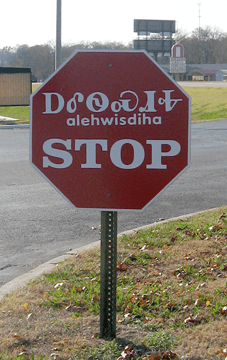
North of Mexico, there were about 296 Indigenous languages spoken or formerly spoken. Most of these belong to 29 language families. The largest families by number of languages are Na-Dené, Algic, and Uto-Aztecan. Uto-Aztecan has the most speakers (1.95 million), mainly because of the 1.5 million speakers of Nahuatl in Mexico.
North America is known for having a huge variety of languages, especially in California. This area alone has 18 language families with 74 languages! This is a lot compared to Europe, which only has four main language families.
Many North American languages have a small number of vowels (like three to five). Languages in the western part of North America often have many different consonant sounds. Some languages in the Pacific Northwest have very complex sound rules, where words can even exist without any vowels!
Here are some of the language families and isolated languages found in Northern America:
- Algic (30 languages)
- Caddoan (5)
- Eskimo–Aleut (7)
- Haida
- Iroquoian (11)
- Keresan (2)
- Kutenai
- Maiduan (4)
- Muskogean (9)
- Na-Dené (39)
- Pomoan (7)
- Salishan (23)
- Siouan (19)
- Tanoan (7)
- Tsimshianic (2)
- Uto-Aztecan (33)
- Wakashan (7)
- Washo
- Yuchi
- Yuman–Cochimí (11)
- Zuni
Languages in Central America and Mexico
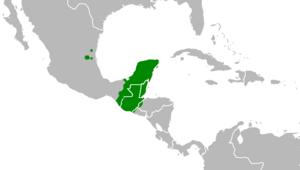
In Central America, the Mayan languages are very important. At least six million Indigenous Maya people speak them, mostly in Guatemala, Mexico, Belize, and Honduras. In 1996, Guatemala officially recognized 21 Mayan languages! The Mayan language family is one of the most studied in the Americas. Modern Mayan languages come from "Proto-Mayan," a language believed to have been spoken over 4,000 years ago.
Here are some of the language families and isolated languages found in Central America and Mexico:
- Chibchan (22 languages)
- Huave
- Jicaquean (2)
- Mayan (31)
- Misumalpan (5)
- Mixe–Zoquean (19)
- Oto-Manguean (27)
- Purépecha
- Seri
- Tequistlatecan (3)
- Totonacan (2)
- Uto-Aztecan (33)
- Xincan (5)
- Yuman (11)
Languages in South America and the Caribbean
South America has an incredible variety of languages, with about 350 still spoken today. Many more were spoken when Europeans first arrived but are now extinct. It's harder for researchers to study and classify these languages compared to North America because there's less information available. Many languages might disappear before they can be fully documented.
Because of this, many relationships between languages are still being figured out. Some proposed connections are strong, while others are still uncertain.
Here are some of the language families and isolated languages found in South America and the Caribbean:
- Aikaná
- Andoque
- Arauan (9 languages)
- Arawakan (64)
- Arutani
- Aymaran (3)
- Barbacoan (8)
- Bororoan
- Cahuapanan (2)
- Camsá
- Candoshi
- Canichana
- Cariban (29)
- Cayubaba
- Chapacuran (9)
- Chibchan (22)
- Chipaya–Uru
- Chiquitano
- Choco (10)
- Chon (2)
- Cofán
- Fulnió
- Guaicuruan (7)
- Guajiboan (4)
- Guató
- Harakmbut (2)
- Hodï
- Huaorani
- Irantxe
- Itonama
- Jabutian
- Je (13)
- Jivaroan (2)
- Kaimbe
- Kaliana
- Kapixaná
- Karajá
- Katukinan (3)
- Kawésqar
- Kwaza
- Leco
- Mapudungun
- Mascoyan (5)
- Matacoan (4)
- Maxakalían (3)
- Mosetenan
- Movima
- Munichi
- Muran (4)
- Mutú
- Nadahup (5)
- Nambiquaran (5)
- Nonuya
- Ofayé
- Paez
- Pano–Tacanan (33)
- Peba–Yaguan (2)
- Puinave
- Quechuan (46)
- Rikbaktsá
- Saliban (2)
- Taushiro
- Ticuna
- Trumai
- Tucanoan (15)
- Tupian (70, including Guaraní)
- Urarina
- Vilela
- Warao
- Witotoan (6)
- Yaghan
- Yanomaman (4)
- Yaruro
- Yuracare
- Zamucoan (2)
- Zaparoan (5)
Writing Systems
Most Indigenous languages today use the Latin alphabet for writing. However, some languages developed their own unique writing systems after learning about the Latin alphabet, often through missionaries. All the writing systems used before Europeans arrived are no longer in use.
| Writing System | Type | Language(s) | Region(s) | Date in usage | Status | Inventor |
|---|---|---|---|---|---|---|
| Quipu | N/A (string) Possibly Logogram? | Aymara, Quechua, Puquina | Andean civilizations (Western South America) | 3rd millennium BCE – 17th century | Extinct | |
| Olmec hieroglyphs | Logogram | Mixe–Zoque languages | Isthmus of Tehuantepec | 1500 BCE – 400 BCE | Extinct | |
| Zapotec script | Logogram | Zapotecan languages | Oaxaca | 500 BCE – 700 CE | Extinct | |
| Epi-Olmec script | Logogram Syllabogram | Zoque languages | Isthmus of Tehuantepec | 400 BCE – 500 CE | Extinct | |
| Izapan scripts | Logogram | unknown Mixe–Zoquean language | Southern Guatemala | Late Preclassic | Extinct | |
| Maya script | Logogram Syllabogram | Mayan languages | Maya civilization: Yucatán Peninsula of Mexico, Guatemala, & Belize | 3rd century BCE – 17th century CE | Extinct | |
| Teotihua script | Logogram | Nahuatl, other | Central Mexico | 100 BCE – 750 CE | Extinct | |
| Mixtec script | Logogram | Mixtecan languages | Oaxaca, Puebla, Guerrero | 13th century – 17th century CE | Extinct | |
| Aztec script | Logogram Syllabogram | Nahuatl | Central Mexico | 14th century – 17th century CE | Extinct | |
| Komqwejwi'kasikl (Miꞌkmaw Hieroglyphs) | Logogram | Mi'kmaq | Nova Scotia, Prince Edward Island, & New Brunswick | 17th–19th century | Extinct | Father Le Clercq |
| Cherokee syllabary | Syllabary | Cherokee | Cherokee Nation, United States | 1820s–present | Active | Sequoyah ᏍᏏᏉᏯ |
| Canadian Aboriginal syllabics | Abugida | Algonquian languages (Cree, Naskapi, Ojibwe/Chippewa, & Blackfoot (Siksika))
Eskimo–Aleut languages (Inuktitut & Inuinnaqtun) Athabaskan languages (Dane-zaa, Slavey, Chipewyan (Denesuline)/Sayisi, Carrier (Dakelh), & Sekani) |
Canada | 1840s–present | Active | James Evans ᒉᐃᒻᔅ ᐁᕙᓐᔅ |
| Yugtun script | Syllabary | Central Alaskan Yup'ik | Alaska | 1900–present | Endangered | Uyaquq |
| Afaka syllabary | Syllabary | Ndyuka | Suriname, French Guiana | 1910–present | Endangered | Afáka Atumisi |
| Osage script | Alphabet | Osage | Osage Nation, United States | 2006–present | Active | Herman Mongrain Lookout |
Images for kids
-
Yucatec Maya writing in the Dresden Codex, ca. 11–12th century, Chichen Itza
See Also
- Indigenous peoples of the Americas
- Language families and languages
- List of endangered languages in Canada
- List of endangered languages in Mexico
- List of endangered languages in the United States
- List of indigenous languages of South America
- Mesoamerican languages


